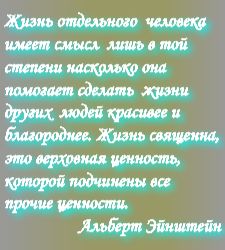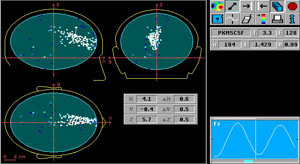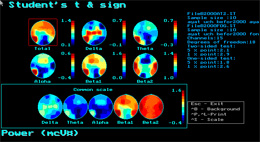|
Transformation of brain activity in altered state of consciousness*
0.I. Koyokina, Ph.D.
INSTITUTE OF TRADITIONAL FOLK MEDICINE, DEPT. OF HEALTH OF THE RUSSIAN FEDERATION, Moscow
Olga I. Koyokina, Ph.D., MD is Senior Research Fellow of the Institute of Traditional Medicine within the Russian Federation Ministry of Health Care. Before her current association she conducted studies in the field of neurophysiology and psychophysiology at a number of institutions of the Soviet and later Russian Academy of Sciences. She has a total of 68 scientific publications, including three patents.
Phenomena usually called altered states of consciousness (ASC) can be observed in people during deep meditation, in transient states of hypnotic induction, and during psi communication between recipients and inductors (psi healers, for instance). These ASC significantly change perception of the ambient world as well as of one’s own body structure: specifically-directed attention restricts the perception of commonly flowing information and replaces it with emotional, image-bearing notions. The rational, logical mechanism of processing information changes to a qualitatively different one with a higher intensity and broader ability for intuitive heuristic analysis that mobilizes the physiological reserves of the brain.
Alternative channels of information transfer and perception that emerge in ASC apparently open the way for mental (non-verbal and non-contact) interaction between individuals or such phenomena as Extrasensory perception (FSP), “out-of-body experience,” “re-mote viewing,” “clairvoyance,” etc. The ability to establish a rapport — a distant extrasensory interaction with another person or environment— is the main distinguishing characteristic of ASC. In this study we analyzed changes in the brain’s electrical activity associated with such states, the nature of which remains unknown.
Neurophysiological studies of ASC related to the continuum “sleep - awakening” or the transient states of hypnosis induction produced unexpected results. Changes in brain activity at deeper stages of transition apparently were closer to normal than those at the initial stages.1 Other studies of human extrasensory abilities2-4 revealed that in the majority of cases changes in brain biorhythms were related to ongoing sensory and psychoemotional activities, while reflections of ESP manifestations were rare. Thus, further studies of the transitional stages toward ASC seemed promising.
The spasmodic transformations of both the psychical function and neurophysiological indicators were first discovered in a study of the stages in hypnotic induction5 at extra-low frequencies (ELF) of the brain potential. Also, saltatory changes of the neurophysiological indicators reflecting connections between brain structures xvere observed in some experienced inductors and psi healers while they remained in an apparently normal state of consciousness.6 These step-like changes hinted at the possibility of some hidden triggering mechanisms that initiate processes in the brain leading to ASC.
Based on the above observations, an assumption was made that the transformation of brain activity in transient stages of ASC, leading to the manifestation of latent, otherwise non-observable features of consciousness, consist of redistribution of bioenergy sources in an otherwise normally functioning brain. This redistribution can be detected as trajectories of consecutive engagements of local neural centers in deep brain structures during the transitional stages of ASC.
METHODOLOGY
A total of 18 volunteers participating in the study formed three groups as follows: the first group was made up of individuals capable of meditating with deep muscular and psychical relaxation resulting in transition into ASC. Another group was made up of neurotic patients undergoing hypnotherapeutic treatment by a psychotherapist. In accordance with the procedure they were led into ASC through phases of somnolence, hypotaxis, catalepsy, and somnambulism. The third group consisted of individuals seeking treatment by a psi healer. They were brought into ASC while being treated by a healer through non-local, non-contact psi communication.
EEG (16 standard monopolar leads, Jasper International scheme) was recorded twice for each participant: at the beginning of the procedure in a normal state of awakening and in ASC. The participants sat in a semidark, sound-isolated room in a reclined position with closed eyes and relaxed. LEG recording continued for several minutes permitting statistical treatment of the fragments of analysis and spectral transformation.
A special computer program BRAJNLOC was used for the purpose of locating the sources of brain rhythmic activity or EEC patterns. The program was developed on the basis of previous studies by V. Gnezditsky and Yu. Koptelov and allowed us to detect and monitor occurrence of the sources of electrical activity within the entire brain volume. The instantaneous distribution of the sources was presented in terms of equivalent dipole** for each time point. Instantaneous current amplitudes registered by a multichannel EEG were used as the input information. The computer program plotted vector momenta*** of electrical dipoles in three-dimensional coordinates for each given instant along with the corresponding 95% confidence intervals. Also evaluated was a coefficient characterizing the adequacy of the dipole model used. In addition, the pro-gram printed out maps showing distribution of the EEC potential and potentials for the dipole model on the skin of the head as well as maps of potentials on the cerebral surface.
* Translated from Russian by S. Savva.
** Dipole is a pair of field sources (electric charges in this instance) of equal magnitude and opposite signs, separated by infinitesimal distance.
Vector momentum is a vector created by multiplying a unit vector (drawn from a negative charge to a positive charge) by the charge value.
RESULTS
Found were common features of ASC associated with a bright, vivid perception of”other worlds,” other time-dimensional correlations, usually with telepathic communications with “other” entities. In some cases reported were “space travels” for relatively short distances, for instance districts of Moscow, or places at distances from a few to thousands of kilometers. In other cases subjects reported travels in time to historic events that happened centuries ago. These were perceived and reported as a current reality. Often the inductor was able to maintain nonverbal contact with a subject directing and controlling transitional stages of ASC.
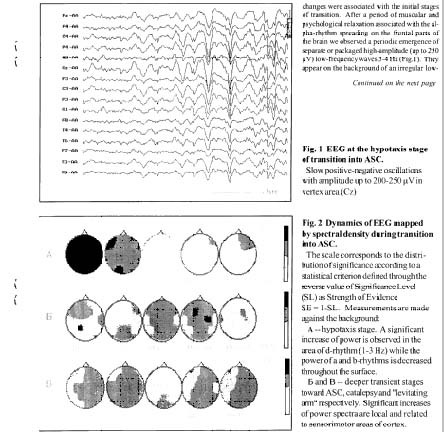
Upon returning to a normal state of consciousness, all the subjects stated that they experienced a different kind of reality, communicated with entities of other worlds, and that it was no ordinary sleep at all. Some subjects reported that they had an “out of body experience.”
A few transient phases in the dynamics of the brain rhythms were identified by analyzing EEGrams in the process of transition into ASC. Most notable changes were associated with the initial stages of transition. After a period of muscular and psychological relaxation associated with the alpha-rhythm spreading on the frontal parts of the brain we observed a periodic emergence of separate or packaged high-amplitude (up to 250 mV) low-frequency waves 3-4 Hz (Fig. 1). They appear on the background of an irregular low waves. The interhemispheric sleeves C7 and F7 show the greatest amplitude. In some subjects periods of low-frequency waves alternate with periods of alpha-rhythms in the frontal-central areas or betha-rhythms. The general picture of statistically significant changes of brain activity during the transitional stages is presented in Fig.2 by mapping the shifts of power spectra of basic EEG rhythms.
During the first stage of the transition from normal to altered state of consciousness. i.e. when subjects establish a rapport with a psychotherapist, at certain stages of meditation, or when contact was being established between inductor and recipient, we observed increases in low frequency power spectra — delta and theta rhythms over the entire brain surface while power spectra in alpha and betha regions diminished (Fig. 2A). The observed changes in biorhythms are characteristic for an inactive inhibited state of the cortex with splashes of high-amplitude low-frequency waves alternating with periods typical for normal awakening or phases of dreaming. These features in EEG were associated with ensuing reporting of transformed perception of space and time by the subjects. By comparing the dynamics of the EEG power spectra in relation to the back-ground in deeper stages of the hypnotic state —catalepsy (Fig.2B) and “levitating arm” (Fig.2C) one can see that in those stages the variation of EEG spectra are much less pronounced than in the first stage (Fig. 2A).
Especially interesting is the concentration of the power of slow positive-negative waves in C7 and F7 areas. The methodology used for calculating the dipole sources of those waves revealed their occurrence in deep structures of the inter-hemispheric area of the brain (Fig.3). This area houses the most important centers generating the ascending influence on brain activity: reticular formation, medial thalarnus as well as areas related to regulatory processes sensitive to light and the reproduction function.
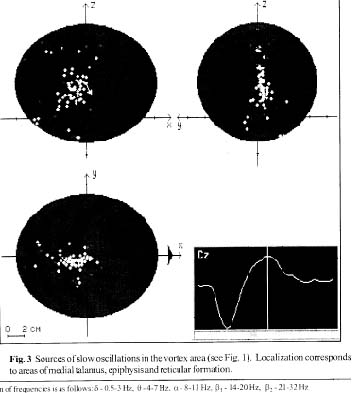
Basically, these areas are adjacent to the walls of the third ventriculus and the epi-physis. The sources are densely concentrated along the transver-sal axis while somewhat dispersed along the vertical and front-back axes of the head. The axes of the dipole sources are distributed similarly. The distribution of the slow potential amplitude’s maxi-mum and minimum on the brain surface (model) and the scalp, cen-tered at the back of the vertex, can be seen in Fig.4 and 5.
High concentration of biorhythms’ energy in the area control-ling activation of the consciousness is apparently related to its involvement in the transformation of the brain activity that is neces-sary for the manifestation of the hidden potentials of the mind. The observed inhibited state of the cerebral areas of the brain which is associated xvith the inhibition of psychical functions in the tran-sient states of ASC, most likely provides a necessary background for reordering some functions and internal connections in the brain related to the opening of alternative channels of perception and information transfer.
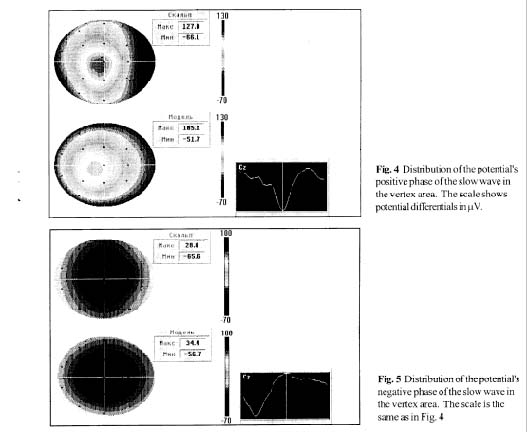
REFERENCES
1. Olejnikov, N. I., Koekina, 0.1., Makarychev, V.A. Psychotropic hvpnogenic effects of reflexotherapy and their application for the enhancement of medical treatment efficacy. Methodological recommendations of the Russian Federation Ministry of Health Care, Moscow, 1995, 20p.
2. Vassilieva G. N., S. A. Lytaev, A. L. Khlunovsky, B. P. Kobrin. Study of energoinforrnation exchange between subjects by means of electroencephalography. Приборостроение (Instrumentation), #6, 1993, Pp. 65-73 (in Russian)
3. Kukes, B, G., 0.1. Koekina, R. Vu. Volkov. Interpersonal connection of bioelectric activity of the brain during bioenergoinformation exchange. Парапсихология и психофизика (Parapsychology and Psychophysics), #1(13), 1994, pp.42-50 (in Russian)
4. Blagosklonova, N. K., A. N. Gusev, Vu. M. Koptelov, S. A. Shapkin. Reflection of extrasensory interaction in EEG. Физиология человека (Human Physiology), V.20, #3, 1994, pp.36-44 (in Russian)
5. Aladzhalova, N. A. Psychophysiological aspects of super-low rhythmical activity of the brain. “Nauka” Moscow, 1979, 214 p. (in Russian)
6. Pavlova, L. P. A Systems Approach in Electroencephalographic Study of Biotelebonds in the Physiological School of Vvedensky - Ukhtomsky. Парапсихология и психофизика (Parapsychology and Psychophysics), #2, 1993, pp.42-48 (in Russian)
7. Koptelov, Vu., Gnezditsky, V. V. Analysis of scalp potential field and three-dimensional localization of the brain epileptic activity sources. Невропатология и психиатрия им. С.С.Корсакова (Neuropathology and Psychiatry), V. 89, # 6,1989, pp.11-18.
8. Shchekutiev, G.A. and Koptelov, Vu. M. Dipole localization method in the analysis of provoked acoustic stern potential. Журнал высшей нервной деятельности (Journal of higher nervous activity), V. 42, # 1,1992, pp.176-185
MJSAHA Newsletter #20-21, January-June, 1998
|





